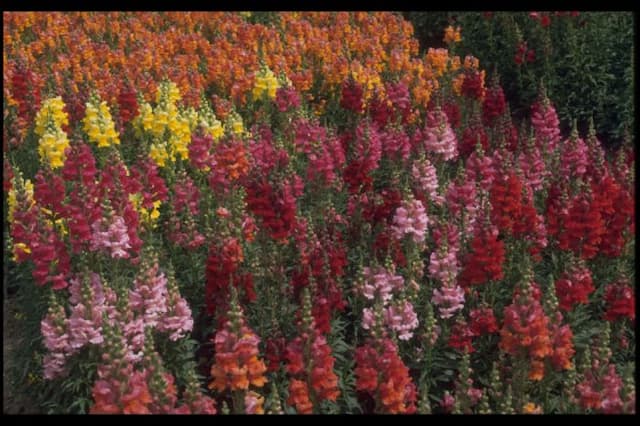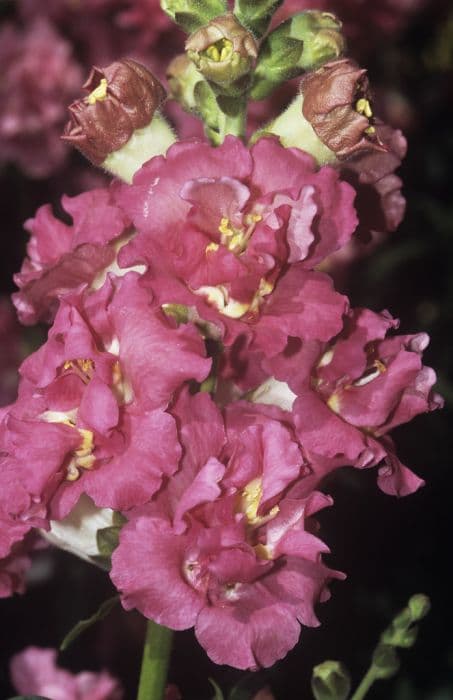Foxglove Digitalis 'Saltwood Summer'

ABOUT
Digitalis 'Saltwood Summer', commonly known as Foxglove, is a strikingly beautiful perennial plant known for its showy and vibrant appearance. The distinguishing features of this Foxglove are its large, tubular flowers that form a dense spike atop tall stems. These flowers come in a blend of soft pinks, purples, and whites, often spotted with darker markings inside which serve to guide pollinators to the nectar. The blooms gracefully hang down, giving the plant a somewhat whimsical look. The foliage of 'Saltwood Summer' consists of thick, textured leaves that are lance-shaped with a slight grayish-green hue. These leaves grow mainly at the base of the plant, creating a rosette from which the flower-laden stems rise. The leaves may have fine hairs and possess a slightly coarse feel. Overall, the Foxglove 'Saltwood Summer' is a classic garden choice for adding vertical interest and a dash of color. It is commonly cultivated for its striking blossoms and is often found in cottage gardens, woodland plantings, and mixed borders where its blooms can attract a variety of pollinators. The flowers and foliage of this Foxglove create an enchanting, almost fairytale-like feel in the garden, making it an alluring choice for many garden enthusiasts.
About this plant
 Names
NamesFamily
Plantaginaceae
Synonyms
Foxglove, Common Foxglove, Purple Foxglove, Lady's Glove
Common names
Digitalis purpurea 'Saltwood Summer'.
 Toxicity
ToxicityTo humans
Foxglove, including the variety 'Saltwood Summer', is highly toxic to humans. All parts of the plant contain cardiac glycosides that can interfere with the heart's electrical system. Symptoms of poisoning can include nausea, vomiting, diarrhea, headaches, abdominal pain, dizziness, confusion, weakness, changes in color vision, and potentially life-threatening heart problems, such as irregular heartbeats or cardiac arrest. Ingesting any amount can be particularly dangerous and should be considered a medical emergency.
To pets
Foxglove is also poisonous to pets, including dogs, cats, and horses. The cardiac glycosides in the plant can cause similar symptoms in animals as they do in humans. In pets, symptoms may include vomiting, diarrhea, drooling, weakness, cardiac rhythm disturbances, seizures, and collapse. If a pet ingests foxglove, it is considered an emergency situation requiring immediate veterinary attention.
 Characteristics
CharacteristicsLife cycle
Biennials
Foliage type
Semi-deciduous
Color of leaves
Green
Flower color
Mixed
Height
2-3 feet (60-90 cm)
Spread
1-2 feet (30-60 cm)
Plant type
Herb
Hardiness zones
4
Native area
Europe
Benefits
 General Benefits
General Benefits- Attracts Pollinators: Digitalis 'Saltwood Summer', commonly known as Foxglove, is known to attract bees and butterflies, helping to pollinate the garden.
- Aesthetic Appeal: With its tall spikes of pink and purple flowers, Foxglove adds height and color to the garden, creating visual interest.
- Shade Tolerance: Foxglove can thrive in partial shade, making it suitable for garden spots that don't receive full sunlight.
- Cottage Garden Style: Foxglove is often used in cottage-style gardens for its traditional look and ability to blend well with other perennials.
- Vertical Interest: The tall, vertical shape of Foxglove can be used to add structure to a garden design.
- Wildlife Habitat: Provides shelter and nectar for various species of wildlife, supporting biodiversity.
- Easy to Grow: Foxglove is known for being low maintenance, making it a good choice for gardeners of all skill levels.
- Seasonal Color: Blooms in late spring to early summer, providing color during a time when many other plants may not be in flower.
 Medical Properties
Medical PropertiesThis plant is not used for medical purposes.
 Air-purifying Qualities
Air-purifying QualitiesThis plant is not specifically known for air purifying qualities.
 Other Uses
Other Uses- A natural dye source: The leaves of Foxglove can be used to make a greenish-brown dye for textiles.
- Indicative plant for soil fertility: Foxglove prefers nutrient-rich soil, its presence can indicate the fertility of the soil in an area.
- Garden aesthetics: Foxglove, with its tall, dramatic spikes of tubular flowers, is widely used for vertical interest in cottage gardens and mixed borders.
- Companion plant: Foxglove is sometimes grown alongside vegetables like tomatoes as it can attract pollinators and potentially improve the yield.
- Bee garden inclusion: Foxglove is excellent for attracting bees and other pollinators to the garden, contributing to the health of the bee population.
- Teaching tool in botany: Its distinct morphological features make Foxglove a good example for teaching plant biology and reproduction.
- Creative inspiration: Artists and photographers often use Foxglove as a subject due to its striking appearance.
- Costume design: The individual florets of Foxglove have been used to create fairy and elvish costumes due to their bell shape.
- Symbolism in flower language: In the language of flowers, Foxglove is sometimes used to symbolize insincerity, given its toxic nature despite a beautiful appearance.
- Themes in literature: Foxglove has been featured in fairy tales and folklore, often associated with fairies and woodland scenes, making it a recurring motif in fantasy literature.
Interesting Facts
 Feng Shui
Feng ShuiThe plant Foxglove is not used in Feng Shui practice.
 Zodiac Sign Compitability
Zodiac Sign CompitabilityThe plant Foxglove is not used in astrology practice.
 Plant Symbolism
Plant Symbolism- Healing: Digitalis, commonly known as Foxglove, has been used medicinally to create digitalin, a compound beneficial for treating certain heart conditions. Its association with healing comes from its use in traditional and modern medicine.
- Beware: As much as it is helpful, Foxglove is also highly toxic if ingested incorrectly. Its symbolism here serves as a reminder to respect nature's power and the fine line between medicine and poison.
- Attraction: Foxglove's bright, bell-shaped flowers attract not only human admiration for their beauty but also a variety of insects such as bees. They symbolize an ability to draw in others, representing magnetism and allure.
- Magic and Folklore: In folklore, Foxglove is often associated with fairies and woodland sprites. It has a whimsical, magical symbolism tied to the belief that fairies could be found around these plants.
- Insincerity: Due to the plant's poisonous nature despite its outward beauty, Foxglove sometimes symbolizes insincerity or deceit, suggesting that things might not always be as they appear.
 Water
WaterFoxgloves need consistent moisture, especially during the growing season, but they don't fare well with waterlogged soil. Water young plants regularly, allowing the soil to dry slightly between waterings, approximately 1 inch per week. For established plants, deep watering every two weeks with about 1 gallon of water per plant should suffice, depending on climate and soil conditions. During periods of high heat or drought, increase the frequency as needed to maintain slightly moist soil. Water at the base to avoid wetting the foliage, which can lead to fungal diseases.
 Light
LightFoxgloves thrive best in partial sunlight to light shade. An ideal spot would be one that receives morning sunlight and afternoon shade, especially in hotter regions. However, they can tolerate full sun in cooler climates, as long as they have adequate moisture. Avoid deep shade as this will hinder their growth and flowering potential.
 Temperature
TemperatureFoxgloves prefer a temperate climate with temperatures ranging ideally between 60 to 75 degrees Fahrenheit. They can survive temporary dips down to 40 degrees Fahrenheit and can tolerate up to 90 degrees Fahrenheit if they are not in direct, hot sun. Consistent temperatures within this range promote the best growth and flowering conditions for the Foxglove.
 Pruning
PruningPrune Foxgloves to maintain their shape and encourage more blooms. Deadheading spent flowers will promote a second flush of blooms. Cut back flower stalks to the ground after flowering if you do not wish for the plant to self-seed. Pruning is best done after the main bloom period in mid to late summer.
 Cleaning
CleaningAs needed
 Soil
SoilFoxglove 'Saltwood Summer' prefers well-drained, moist soil with a pH of 5.5 to 6.5. A good mix would be equal parts loam, peat, and sand to ensure proper drainage and fertility. Mulching will help maintain moisture consistency.
 Repotting
RepottingFoxglove 'Saltwood Summer' typically does not need repotting often as it's a biennial, meaning it completes its lifecycle in two years. It can be sown directly in the ground or started in containers if necessary.
 Humidity & Misting
Humidity & MistingFoxglove 'Saltwood Summer' thrives in average humidity levels typical of outdoor conditions. It does not require any special humidity considerations when planted outdoors in its suitable climate zones.
 Suitable locations
Suitable locationsIndoor
Place near a window for bright, indirect light.
Outdoor
Plant in partial shade, moist, well-draining soil.
Hardiness zone
4-9 USDA
 Life cycle
Life cycleThe life cycle of the Foxglove 'Saltwood Summer' begins with seed germination, occurring in warm, moist soil typically in spring or after the last frost. The seedlings emerge and develop into rosettes of oblong leaves at the base. As the plant matures, it develops a tall spike with tubular flowers ranging from pink to purple, usually in the second year (biennial habit), attracting pollinators like bees and hummingbirds in summer. After flowering, the plant produces seeds within small capsules, which disperse for reproduction. The parent plant often dies after seeding, completing its life cycle, but it may behave as a short-lived perennial in some conditions, possibly producing flowers for more than one season. The cycle continues as new seeds germinate, ensuring the propagation of the species.
 Propogation
PropogationPropogation time
Spring-Early Summer
The Digitalis 'Saltwood Summer', more commonly known as Foxglove, is best propagated through seed starting indoors in late winter or early spring. The most popular method involves gently pressing the tiny seeds onto the surface of a well-draining seed starting mix within a flat or container. Foxglove seeds need light for germination, so they should not be covered with soil. The container should be kept at around 70°F (approximately 21°C), and the soil should be maintained moist but not waterlogged. Germination can be expected within 14-21 days. Once seedlings have developed and the threat of frost has passed, they can be transplanted outdoors to their final location, taking care not to disturb their delicate roots. It's important to space them properly, usually about 12 to 15 inches (30 to 38 cm) apart, to allow for adequate air circulation and growth.





![Snapdragon [Pretty in Pink]](/_next/image?url=https%3A%2F%2Fplants-admin.emdemapps.com%2Fimages%2Fplants%2F%2Fimages%2F604b5cb3b5385.png&w=640&q=75)



